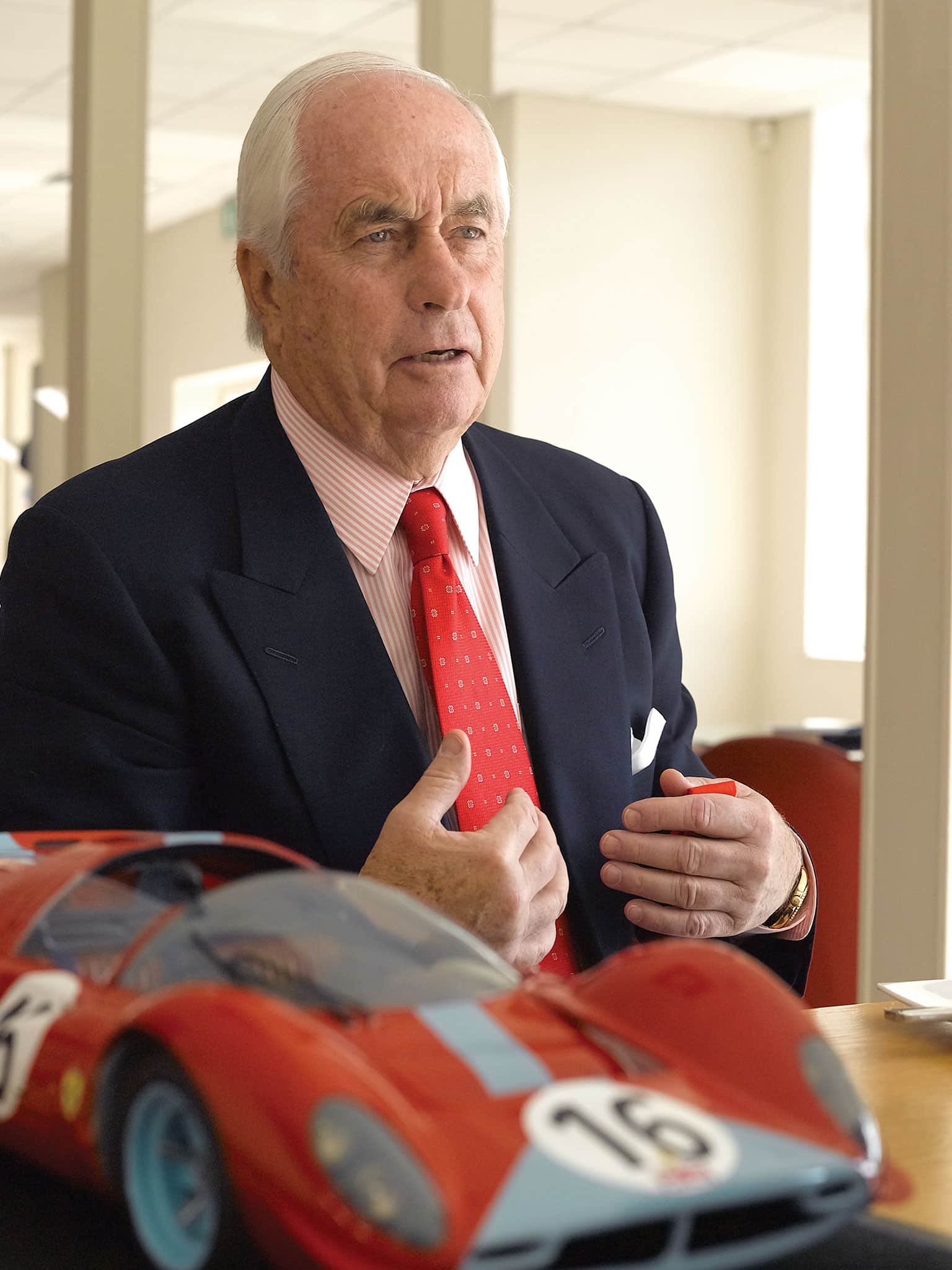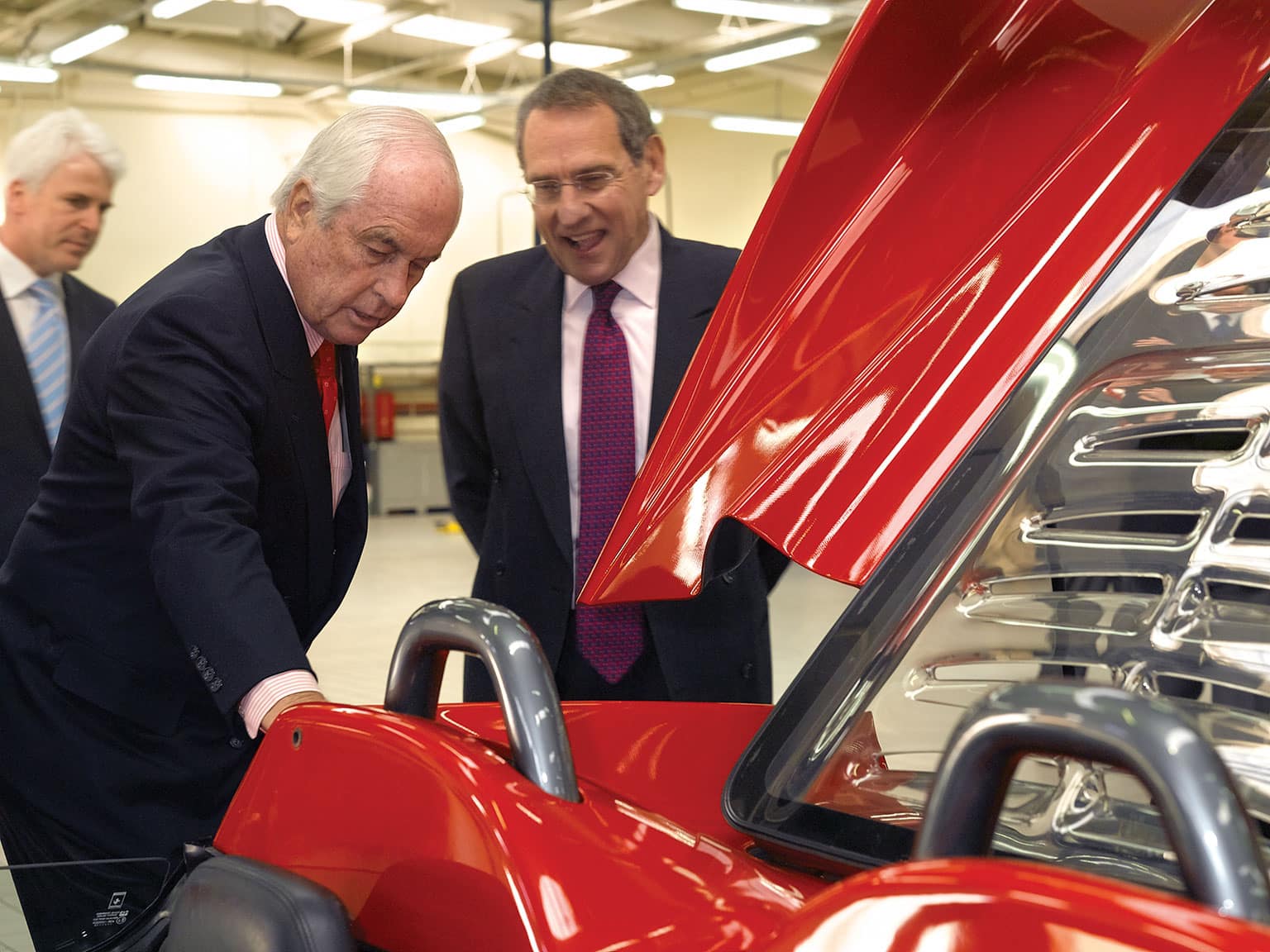Breakfast with... Roger Penske
He started out as a racing driver, but it’s as a businessman that Penske has really achieved results. And such is the pace of life for this 73-year-old that he only had time for coffee and a croissant
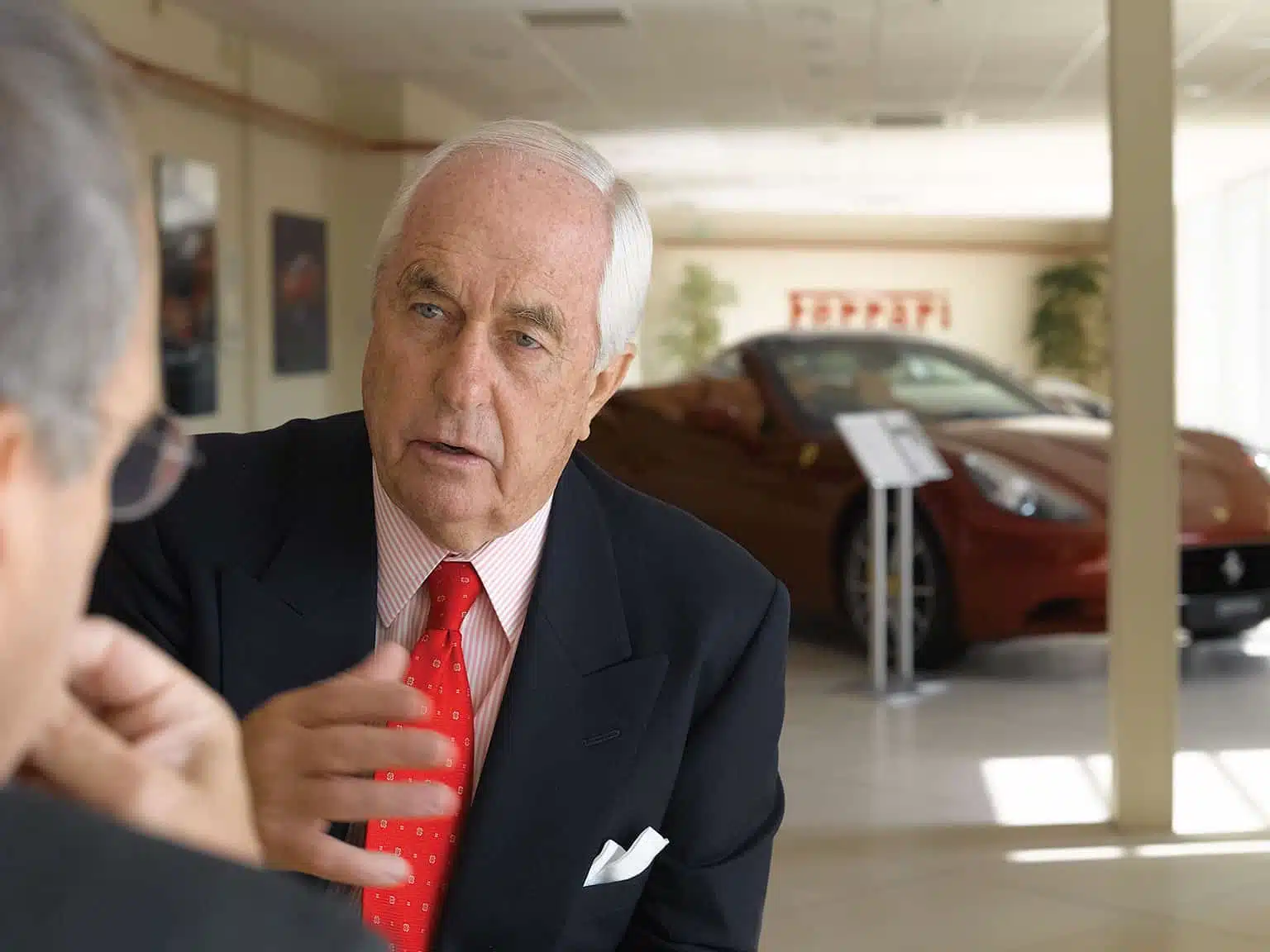
James Mitchell
I’m always fascinated by what racing drivers do with themselves when they hang up their helmets. For some, their cockpit careers are the high point of their lives: afterwards, the only way is down. Others shrug off their racing overalls and use the talents that made them good on the track to find success in other arenas. And one or two regard their motor racing merely as something they did in their youth, a rite of passage, from which they have moved on to more important things.
By any measure, Roger Penske is an extraordinary human being. He is 73 now, a fit, tall-striding bundle of energy who controls hundreds of different companies worldwide and employs 36,500 people. You’ll find him in the Forbes List of the World’s 400 Richest, with a net worth of around $2 billion. He controls a mammoth truck-leasing organisation which operates in four continents. He owns car dealerships – at the last count, 329 of them, spread across America and Europe. He manufactures diesel engines in Italy, truck mirrors in England and fluid level management systems in Michigan. He has factories producing electrical systems and truck parts from Puerto Rico to Poland. He is a director of General Electric, has been the chairman of the Detroit Superbowl, and is a former director of Gulfstream Aviation. When General Motors was going through its recent difficulties he made a bid for one of its divisions (although, once he’d had a close look at their accounts, he withdrew his offer). He has owned and developed race tracks across the USA, and his other interests range from logistics and IT to a ski resort in Utah. He is also a philanthropist, and a driving force behind the regeneration of urban Detroit.
Yet motor racing still consumes him. He runs an incredibly successful Indycar team: 15 Indianapolis 500 victories, 12 national championships, 147 race wins and counting. He is a major player in NASCAR too, with a five-car Dodge team running in the two top series. And with this, as with all his myriad activities, he is totally hands-on. He gets involved, imposing everywhere his uncompromising standards of presentation, cleanliness and attention to detail, and motivating everybody from race drivers to truckies with an indomitable will to win. They all know he’s a racer, and they respect him for it. They call him The Captain.
I’ve long wanted to understand what makes Penske tick. He seems to work seven days a week, 52 weeks a year, and because his interests are spread across continents he is constantly on the move. I offered to meet him at his choice of venue anywhere in the world, but he’s not a man you can easily pin down to a lunch table. He has little interest in talking about his own racing career, because he doesn’t have that sort of ego. What gets his attention is not the past, or even the present. His focus is constantly on the future: tomorrow’s opportunity, tomorrow’s race, tomorrow’s deal. Talking about himself bores him. What he loves to talk about is his people, his key players, the rising stars among those 36,500 employees. It’s the Penske people who matter, he says. They make the story.
Eventually he agrees to breakfast. Among the plethora of British businesses he now owns is the hallowed English Ferrari dealership on the Egham bypass, Maranello Concessionaires. Over a Sunday night his Gulfstream G450 executive jet is bringing him from Nantucket Island, where he has a house, to Farnborough. He’s flying in to address a meeting of 800 of his UK managers in the ultra-modern glass tower beside the M4 Chiswick Flyover that is Audi West London – he owns that, too. But he also wants to see the results of his major investment in Maranello’s parts and service operation, so he’s calling in there first. He suggests we meet there.
Even though Roger jets in to the UK roughly once a month, at Maranello there is still the feeling of a royal visit, with everyone on tenterhooks waiting for the boss to arrive. The Egham showroom, with its gleaming line-up of new Ferraris and Maseratis, is as spotless as ever, but the floor has been polished a second time already this Monday morning. Promptly at 7.30am The Captain strides in, looking crisp and groomed despite his overnight flight. With him is his son Greg, who’s involved in several of his operations. (One of Greg’s responsibilities is Longo Toyota in Los Angeles, the largest single car dealership in the world. When the sun’s shining, it sells a car every eight minutes.)
Roger’s people skills are extraordinary: even the receptionist is greeted by name, as is every salesman on the floor. He has a pertinent comment for each, which shows he’s aware of their roles – and their latest sales figures. Then a Maserati Quattroporte whisks us off to the after-sales facilities: spotless servicing bays, and a huge parts warehouse decked out floor to ceiling with rows of multi-storey racking. Roger, totally involved as usual, hustles me up a ladder to show me £6 million-worth of classic Ferrari spares going back to the 1950s: a row of hand-beaten Pininfarina wings in primer here, a shelf of downdraught Weber carburettors there. In both locations he greets staff like old friends, and seems to know everybody by name. Back at the showroom, I prevail upon him to pause for a coffee and a croissant.
“There was no automotive interest in my family. As a young man I guess I just liked cars. In high school I had a Norton motorcycle, and I started buying old wrecks, fixing them up, selling them on. I worked up to a fuel-injected Corvette, and in 1958 I started doing local SCCA races with that.” By 1959 it was a Porsche RSK, and he was winning at national level. By 1960 he was class champion. The wins continued with a Birdcage Maserati and a Cooper Monaco, and in 1961 he was overall SCCA Champion. By now he’d talked some sponsorship out of chemical giant Dupont, promoting its Telar anti-freeze. “The SCCA didn’t allow sponsors’ names on the car, so I covered them up with adhesive tape. I arranged it so the tape’d blow off after about three laps.”
For the 1961 US GP at Watkins Glen, Penske organised a ride in an F1 Cooper-Climax. In exalted company among the works teams, he came home eighth. Walt Hansgen was less fortunate: he crashed his Briggs Cunningham-owned Cooper trying to avoid the spinning Lotus of Olivier Gendebien. Roger, who’d thought of a way to improve on his Cooper Monaco, approached Briggs in the paddock and bought the wreck, plus one of two special 2.7-litre engines that Coventry Climax had prepared for Cooper’s Indianapolis foray with Jack Brabham that year. The bent chassis was straightened and, having read the sports car regulations carefully, Roger had a neat all-enveloping aluminium body made, retaining the central seating position. A token passenger seat was fitted between the left-hand wheels, with the fuel tank on the right and tiny headlights in the radiator intake. The car was painted red and christened the Zerex Special, after another Dupont anti-freeze brand. “I think Dupont gave me $5000 for the season.”
The beautifully finished car was ready for the 1962 Riverside Grand Prix, a big-money race which attracted the likes of Jack Brabham, Bruce McLaren, Dan Gurney and Masten Gregory. The Zerex beat them all. A week later, at Laguna Seca, Roger did it again. Reports of the day noted that his take from the two events was $20,000 and a new Pontiac, plus the $700 he’d cleared at the Las Vegas tables between the two. Two weeks later the Zerex won again in Puerto Rico.
At Riverside there’d been mutterings about the Zerex’s centre-seat layout. “I just pointed out that, further down the grid, there was an old Bobtail Cooper with exactly the same layout. That seemed to settle it.” However, the establishment wasn’t happy about being beaten by what it felt was merely a wide-bodied F1 car, and at the end of the season centre seats in sports car racing were banned. “So I changed it to side-by-side seating, moving the cockpit tubes wider. It wasn’t very comfortable, but it worked. In 1963 we took it to Brands Hatch for the August Bank Holiday race, the Guards Trophy, and we won there.” Now running in the blue colours of John Mecom’s team, the Zerex also won at Marlboro, Cumberland and Nassau.
In early 1964, in search of more power, an alloy Oldsmobile V8 was readied, but before it could be fitted the Zerex was sold to Bruce McLaren. Bruce bought the Olds engine too, and after a couple of wins in Climax-powered form he debuted the now stiffened, V8-powered machine at the Mosport 200 in Canada, and won. So the little Zerex was the seed-corn of a great motor racing marque: the very first McLaren, the Olds-powered M1 prototype, followed three months later.
Roger was now seen as one of America’s most promising rising stars. He’d had another F1 ride in the 1962 US GP, in a Lotus 24 V8. In John Mecom’s Ferrari GTO he scored a couple of wins in Nassau and, with Augie Pabst, took the GT class and fourth overall at Sebring in 1963. At Le Mans Luigi Chinetti’s North American Racing Team paired him with Pedro Rodríguez in a Ferrari 330LM. They were lying third when a blown engine sent Roger off the road. He raced another GTO in the Goodwood TT, splitting the Lightweight E-types of Salvadori and Sears in qualifying. That year he also did his one and only NASCAR race, a 250-miler on the Riverside road course in a Pontiac. He won it.

Donohue/Hobbs Ferrari 512M was third at 1971 Daytona 24 Hours. Roger is on the left of car
Motorsport Images
For 1964 he joined Jim Hall’s Chaparral operation to drive one of the futuristic auto-transmission 2As. He usually played obedient second-string to Hall – the cars finished 1-2 at Watkins Glen and Meadowdale – and then, after Hall broke an arm in a big accident at Mosport, Roger took the 2A to victory at Laguna Seca. His last meeting as a driver was the Nassau Speed Week in December. He swept the board, winning the TT in Mecom’s Corvette Gran Sport, and then both the Nassau Trophy and the Governor’s Trophy in the Chaparral. In the latter he started on dry tyres, and when it rained he crashed. So he took over team-mate Hap Sharp’s 2A, and brought it through to win.
But Roger has little interest in any of this. “Some people sit down and work out the chronology of all they’ve done in racing, but I’ve never had the time to do that. I’m about now, not then. I’m about how we go forward. But I can tell you why I retired from racing. For a while my goal had been to become a Chevy dealer, and in August 1963 I joined McKean Chevrolet in West Philadelphia. But General Motors were strictly not involved in racing then, and their policy was, no racing drivers as dealers. They said they wouldn’t give me a franchise if I was racing. So I had to make a decision: do I want to be a businessman, or do I want to be a racing driver? Well, I wanted to build a business. So in February 1965 I announced my retirement, and I bought the McKean dealership.”
Barely a year later he was back in racing – but as an entrant. “Sun Oil’s Vice-President of Marketing walked into the showroom, and we sold him a Corvette. Then we persuaded him to give us $2500 towards running in the Daytona 24 Hours. That was the start of a long relationship with Sunoco.” Roger got GM to release a Sting Ray with the still very new alloy-block 7-litre engine. At Daytona one of its drivers, George Wintersteen, ran into the back of a Morgan during the night and it sustained severe front-end damage. It wiped out the headlights, so Roger taped torches to the front wings: they gave the drivers no illumination, but nothing in the rules said how powerful the headlights had to be. The radiator was leaking badly, so Roger found a Corvette owner in the car park, and persuaded him to sell the radiator off his car. After 24 hours the battered Corvette struggled home to win the GT class. The following month, immaculate again and now in Sunoco’s dark blue colours, it won its class in the Sebring 12 Hours. For Roger Penske, entrant, it was an auspicious beginning.
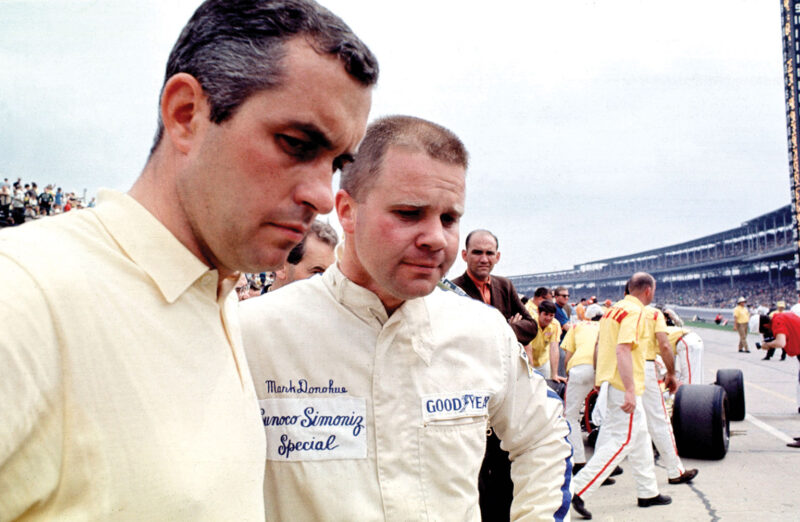
Penske and Donohue at Indy in 1969, theirs was a close working relationship
Motorsport Images
At the Le Mans test weekend that April the great American racer Walt Hansgen was killed in a Ford GT Mk 2. At his funeral Roger talked to Hansgen’s young protégé and Ford co-driver Mark Donohue. The two had first met in 1960, when Donohue was starting out in SCCA racing with an Elva Courier. Penske gave the newcomer a piece of advice, which Donohue quoted in his wonderful book, The Unfair Advantage. “He stressed that if we were going racing [in whatever category] we should only go first class.” Roger – no doubt aware of Mark’s talents as an engineer as well as a driver – made him an offer. It was the start of a close and deep working relationship that was to last the rest of Donohue’s life.
Almost at once, the Penske/Donohue pairing became a towering force in US racing. They dominated Trans-Am with a series of highly developed Camaros and later AMC Javelins, and the USRRC with Lolas and then a McLaren M6A. With the highly intelligent, deep-thinking Donohue developing the cars in the workshop as well as in the cockpit, the wins piled up. Always the Penske operation was the most immaculate in the paddock, every item polished, every detail considered. In Technical Excellence at Speed, Michael Argetsinger’s flawlessly-crafted biography of Donohue, long-time team member Karl Kainhofer is quoted thus: “Roger is always two steps ahead of you, always trying to improve on what you think is perfect. But he’ll also listen to you, and change things in a second if he thinks your idea is better.”
For Roger, USRRC and Trans-Am titles weren’t enough. In 1968 he took the hard-working Donohue into Indy racing. Sometimes Mark would do an Indy race and a Trans-Am race in different states on the same weekend, flying between the two. In his first Indianapolis 500, with a Lola-Offy, he qualified fourth and finished seventh to be rookie of the year. In 1970 he was second. In 1971, now in a McLaren, he led but the gearbox failed. In 1972 he won.

IRL line-up includes former Indy 500 winner Helio Castroneves, pictured at this year’s Long Beach GP
Steve Swope
Penske tackled NASCAR too, with an AMC Matador, and Donohue won the 1973 Riverside 500, echoing Roger’s Pontiac victory at the same track 10 years before. But the Can-Am Series, apart from a couple of isolated wins for Mark, was still locked up by the orange works McLarens.
At Le Mans in 1971, where Donohue and David Hobbs were sharing Penske’s Sunoco-blue Ferrari 512S (a car substantially redeveloped by Mark), Roger was quietly approached by Porsche. Having dipped a toe in the Can-Am pond with a Spyder 917, the Germans wanted to mount a serious assault. Mark spent weeks at Zuffenhausen, totally involved in the project, and the result was the extraordinary twin-turbocharged, flat-12 917/10K. It vanquished the McLarens and won the 1972 Can-Am, but in George Follmer’s hands, not in Donohue’s: Mark was injured in a mammoth testing crash at Road Atlanta when the rear bodywork came away at over 150mph. On crutches, he continued to help direct the car’s engineering, and was back in the cockpit before the season’s end.
For 1973 Porsche and Penske produced the 917/30, one of the most fearsome racing cars of all time: 1100bhp – or up to 1500bhp if the driver turned up the boost – and 850kgs dry. (With the 88-gallon fuel tanks brimmed, that weight went up somewhat.) Acceleration was in the order of zero to 100mph in 3.8sec, and zero to 200mph in around 12sec. Later, Donohue’s world closed-circuit record at Talladega of 221.12mph showed that the straightline maximum was over 250mph.
Donohue dominated Can-Am in this monster. Then, after winning three of the four Penske-promoted IROC Porsche RSR races, he announced his retirement. The relentless seven-days-a-week schedule of testing and racing in several series at once had left him exhausted. At 36, he was appointed President and General Manager of Penske Racing Enterprises. And Roger Penske announced that he had taken over the McRae workshops in Poole, Dorset, to build a Formula 1 car.
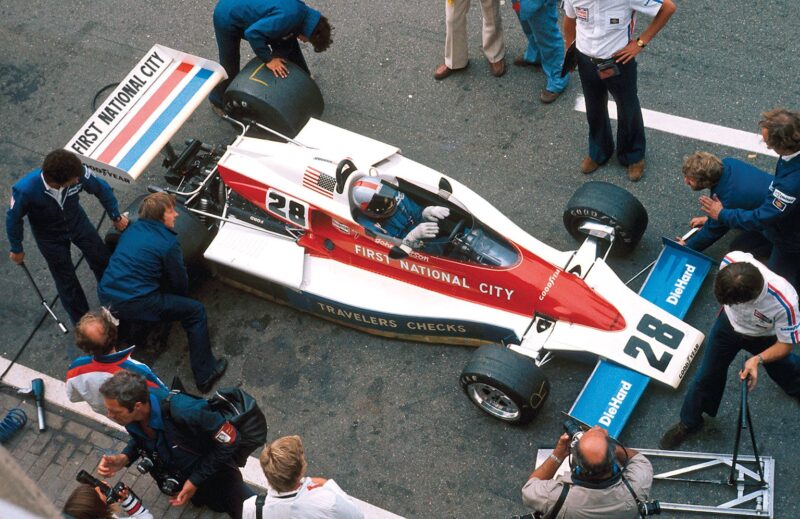
John Watson scored Penske’s sole F1 win at Austria in 1976
Motorsport Images
Roger’s competitive spirit had long been nudging him towards F1. For the 1971 Canadian GP he’d arranged for Mark to drive the second McLaren alongside Denny Hulme. In the Mosport rain Mark finished a brilliant third in his first Grand Prix, never running lower than fourth despite a pitstop for fresh goggles. Now, in 1974, he had to grapple with life as a retired racing driver, and he found it far more difficult than Roger had done, nine years earlier. The F1 Penske was slated to make its debut in the Canadian Grand Prix in September. On August 29 all media and public were barred from Mosport, and the new car was tested by a driver in an unmarked helmet. On September 13 Donohue announced he was coming out of retirement to race in Formula 1.
The Geoff Ferris-designed Penske PC1, in the red, white and blue colours of First National City Travellers Checks, was of course immaculately turned out, but inevitably F1 was a steep learning curve. Mark’s first points finish came in its ninth Grand Prix, fifth at Anderstorp. The car consistently lacked speed so, mid-season, Roger decreed a switch to a March 751 while an improved Penske was built. During the Sunday morning warm-up for the Austrian GP, in the fast uphill right after the pits, a left-front tyre failed. The March leaped the guardrail and crashed heavily, and a metal bar supporting a hoarding hit Mark’s helmet. He was concussed, but in the ambulance he was talking rationally. A few hours later he lapsed into a coma. He was flown by helicopter to Graz and had a four-hour operation to remove a blood clot from his brain. On Tuesday evening Mark Donohue died.
Over our breakfast, Roger is poker-faced when I ask him about Mark. It’s clear that, 35 years on, he still feels the loss of his friend. “Today’s medical facilities are so much better. Maybe today we could have done something, and saved him. Mark was totally dedicated to racing. He was a very fine engineer, and he had the technical ability to take things much further than I could, while I looked after the business side. In personality he was introverted, but we really communicated well. Plus I’d raced, so I understood the pressures a driver goes through. Our goal was to win Indy, which we did, and Can-Am, which we did. We were in F1 for one reason, because Mark wanted it.”
It’s a cruel irony that Penske’s finest moment in Formula 1 came without Mark, and at the very same circuit. “It was one year on from when we lost him that we won the Austrian Grand Prix. Racing is like that. One day it’s tragic, next day you’re thinking, well, we won this one.” In the much-improved PC4 John Watson was third at Paul Ricard and fourth at Brands Hatch. Then at the Österreichring Wattie led all but nine of the 54 laps to score a brilliant victory – after which, at Penske’s insistence, he famously shaved off his beard.

Roger is proud of ALMS campaign with Porsche RS Spyder, which included 2008 Sebring 12 Hours victory over Audi
Motorsport Images
At every level of the Penske organisation, Roger insists that people as well as machinery are smartly turned out – spotless pressed clothes, short haircuts, clean-shaven. “It’s true, when John joined us there was a discussion about his beard. I wasn’t too keen on it.” So they did a deal: as soon as the Penske won a Grand Prix, John would shave his beard off. He was true to his word, and has been beardless ever since. According to Argetsinger, when David Hobbs was hired as Mark’s co-driver in the Ferrari 512S, Roger suggested that David might want to visit a barber to attend to his English-length locks. “Not a chance,” said Hobbs, and nothing more was said.
But a drive for Penske was always a feather in any driver’s cap. “People can’t buy rides with us,” says Roger. “That shows weakness in a team. We hire the best drivers, and if we can’t afford the best we won’t be racing. That’s always been our DNA. I say to my drivers, ‘You got the ride, now run the way you need to run to win.’”
Following the Austrian victory Penske, with a singleton entry against two-car teams, was lying fourth in the Constructors’ Championship. But at the end of the season Roger pulled the F1 plug, and the cars were sold to ATS. “We were doing F1, Indy, Can-Am, Trans-Am, IROC. We had a full plate. It was time for me to make a business decision. We didn’t then have the international footprint that we have today, so we said, ‘Let’s concentrate on US racing.’ Since then Bernie [Ecclestone] has talked to me a number of times about starting an American F1 team. But if you’re in anything you’ve got to be able to go to the top, so that when people talk about the best teams they’re talking about your team. The investment required just to get onto the grid, the capital needed to get properly into the technology, is huge. Look at USF1, they couldn’t even get started. I have great regard for F1’s top teams, Ferrari, McLaren and the rest, but I’m an American. We’ve got so much good racing in the US, and we need to win the NASCAR championship and do things like that before we get back into F1.
“Bernie has done an outstanding job bringing F1 to where it is today. In every country it goes to, it’s a tremendous event. But in the US we race 35 or 40 weekends a year, and the average NASCAR race has 100,000 spectators at every round. Real paying spectators, not like some F1 races in the Middle East with lots of guest tickets. There’s got to be changes in F1, because of the technological costs. And they need to do something about the spectacle. The race starts, it all happens into the first corner, and after that… The guys in the stands, the guys who’ve paid, most of them aren’t interested in the details of F-ducts or diffusers or carbon brakes. What they know is the red Ferrari, the blue Red Bull, the silver McLaren, the white Mercedes. And they know Fernando and Mark and Lewis and Michael. Build the drivers, make them the stars. That’s what people understand.”
Roger has been in Indycar, through USAC, Champ Car and the IRL, for an incredible 43 seasons. He was a major chassis builder for many years, but the cars are now Italian Dallaras, using the Honda-badged Ilmor engine. And Ilmor is another Penske company. “Back in 1983 Mario [Illien] and Paul [Morgan] came to my home with a handwritten business plan. I read it, and I said, ‘Let’s go.’ We started with the Chevy V8, Rick Mears won Indy for us with that, and we went from there. In the end we sold off the F1 side to Mercedes. The guts and feathers of the McLaren and Brawn engines came from Ilmor, so you could say we’re involved, indirectly, in today’s F1. We build the Indy motors in England at Brixworth, and Ilmor US does all the servicing. We lease the engines to the teams, so it’s quite a good business for us. There are Chinese walls, the IRL guys control the engine numbers, and when you get your new engine you don’t know what number you’re getting. There’s never been a complaint that the engines aren’t all exactly the same.”
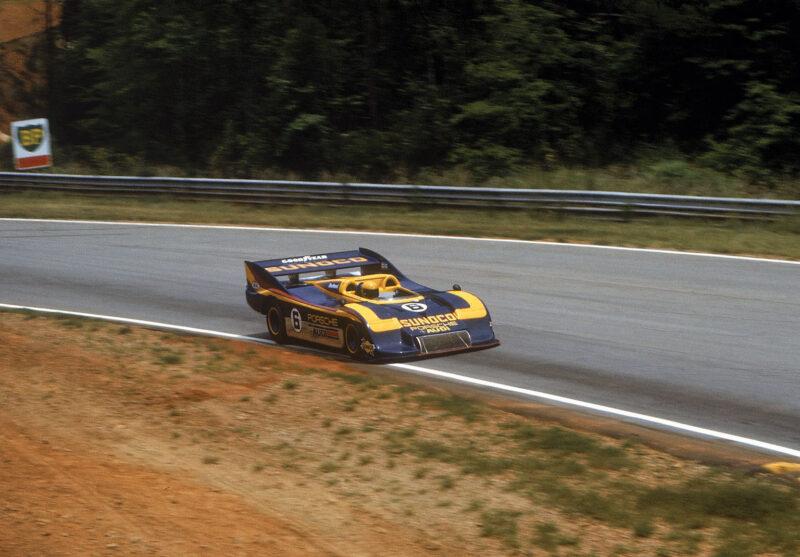
Donohue practises 0-100mph in 3.8sec aboard Porsche 917/30 in 1973 Can-Am outing
Motorsport Images
Typically, Penske Indycar statistics – all those wins and titles – don’t interest Roger much, but one season he singles out is 1994 (see feature on p94). “We did the stock-block Mercedes engine in great secrecy, didn’t announce it until two weeks before Indy. Buick had been doing pushrod engines for years without much success, but we sat on pole, won the race, led every lap but about three. The key Mercedes directors flew over, came into the garage in their business suits and ties, took them off and put on Penske Mercedes shirts. Then I knew we’d arrived. We won 12 of the 16 rounds that year.”
His drivers today are the Brazilian Hélio Castroneves and Australians Ryan Briscoe and Will Power. This year’s Indy 500 – although Castroneves started from pole, with Power second and Briscoe fourth – didn’t go so well, but Power still leads the 2010 Indycar standings, with Castroneves fourth and Briscoe seventh. “Hélio’s got over that unfortunate court case [last year he was accused by the US authorities of tax evasion]. They made it into a witch-hunt, but he was completely exonerated, and he won his third Indy a few months later. Briscoe is super – he had the title all but won last year. In Japan he was nearly a lap ahead of the field, then he had that accident in the pitlane, knocked the front suspension off. Lost him the championship right there. Will is a great young driver, very committed. At Sears Point a guy spun and Will T-boned him. It broke his back, but he came back and won the first two rounds this season, nearly won three in a row.”
After his initial forays into NASCAR, Roger withdrew from that series in 1980. But he couldn’t ignore such a fundamental part of American racing, and in 1991 he was back, first with Pontiac, then Ford and now with Dodge. There have been many wins and many great moments, like Penske’s 1-2 in the 2008 Daytona 500 with Ryan Newman and Kurt Busch, but the NASCAR Sprint Cup title is a goal that Roger still has to score. This year the Dodge Chargers are raced by Busch, Brad Keselowski and Sam Hornish, with Justin Allgeier in the Nationwide series. In May Busch won the season’s longest race, the Coca-Cola 600 at Charlotte.
“We build our NASCAR cars top to bottom. We build the chassis, we hang the bodies, we get block castings from Dodge and we build our engines. NASCAR’s reach is a lot bigger than Indycar, apart from the Indy 500. The fan base is just gigantic, there are TV shows every night, you’ve never seen such passion for the favourite drivers. And cars: there are Ford fans, Chevy fans, Dodge fans, Toyota fans. You’ve got a level playing field, and it’s the tightest racing I’ve ever seen. It’s tough, too. Look at [Juan Pablo] Montoya. Good as he is, he’s now in his fourth year and it’s been a long transition for him. We’ve brought Sam Hornish over from open-wheelers, and he’s struggled to get to where he wants to go. Under the France family, NASCAR has been consistently strong for so long. In Indycar we had the split with Champ Car and the IRL but, now it’s come back together, we’ve got better fields than we ever had. There’s 12 or 14 cars that can win every race, and it’s the same in NASCAR. I’m not sure that’s true of F1.”
One programme that Roger mentions with pride is his three-season ALMS campaign for Porsche in 2006-8. The Penske-run 9R6 Porsche RS Spyders won the LMP2 title all three years, and also outright victories, notably the 2008 Sebring 12 Hours. “That was one of our best wins in recent years, beating the LMP1 Audi R10s that won Le Mans. It was good to work with Porsche again. Wolfgang Dürheimer, their R&D boss, he’s a very competitive, highly motivated guy. If Porsche ever decides to do Le Mans again, we’d love to be part of that. I’m not someone who collects old race cars for old times’ sake, but I do have that Sebring-winning Porsche, in 100-point condition.”
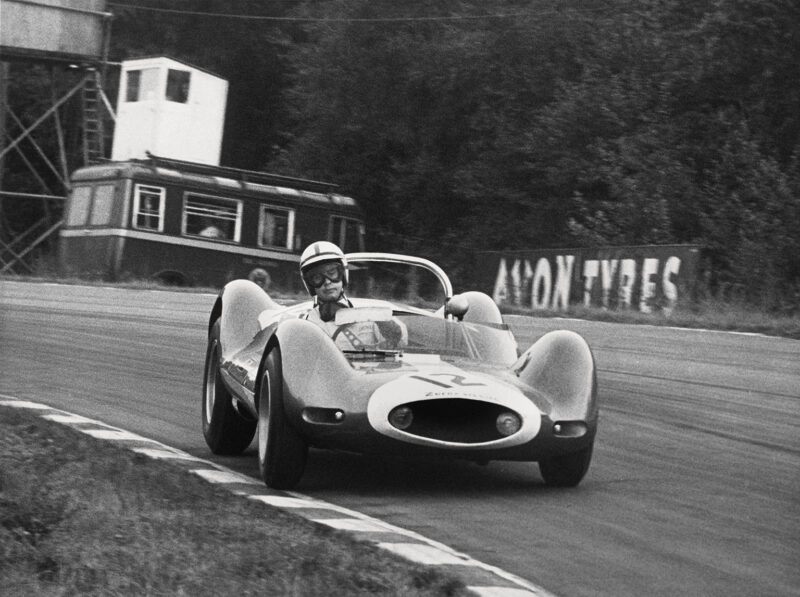
Penske in the Zerex Special now with side-by-side seating, en route to Guards Trophy win at Brands Hatch in 1963
Motorsport Images
Roger has also been a circuit owner. “We started with Michigan, which we bought in 1972. Then we bought Rockingham in North Carolina, we did a joint venture with Homestead in Florida, and in 1997 we built the California Speedway in Fontana. But we’ve sold them now, to the France family. Since then we’ve done Belle Isle, that’s something I wanted to do for the City of Detroit. We have a great circuit there, a semi-permanent road course. Because the economy in the area has been a mess we haven’t run there in the last two years, but we have all the pieces, the fencing, the barriers, and I see it as a place where we can run a really big event.”
The state of downtown Detroit after the financial crisis concerns him deeply. “The city is shrinking. It used to be two million people, now it’s 900,000. Three-quarters of the city’s kids never graduate from high school. I’m head of the Downtown Detroit Partnership, pulling the private equity people together to recreate the downtown area. It’s safer now, we’ve got a great new mayor, we’re working on charter schools, we’ve got a new medical group to reinvigorate the hospitals, and I think we’re really making a difference. When I was a kid I was sent to Culver Military Academy in the summer, that’s where I learned to be tidy and neat. We’re taking inner-city kids and putting them through the same school. All the success, all the winning in the world, doesn’t mean a thing if you can’t put something back. After the Haiti earthquake, through all our companies, very quickly we shipped a million dollars’ worth of heavy-duty trucks in there to move food.”
I suggest to Roger that the huge investment in money and energy that he still pours into motor sport has to be for one of three reasons: because it’s lucrative, because it’s good promotion for his other businesses, or because he just loves it. “Lucrative no, because we run a zero-based operation in racing. Everything we make we put back in, in equipment, in people. I guess you’d have to say the primary reason is, I love it. I’m a busy guy, I’m never going to run out of things to do, but racing is my golf game, my fishing trip, my skiing holiday. I do play golf, I do ski, but what I love is being personally involved in racing, sitting on the pitwall. That said, we try to use racing as a common thread in everything we do. It creates momentum. You can’t put a price on the value of how racing builds your brand. It ties in with everything we’re trying to do: execution, teamwork, quality, reliability, integrity. Those are all ingredients you need to win, in racing and in business. Look at Ron Dennis, look at Bernie: they’ve succeeded in business because they understand racing.
“Racing’s a model for any business: you’ve got to motivate, you’ve got to think ahead, you’ve got to manage it through the down periods, and you’ve got to develop your people. That’s a key lesson: everybody matters. The guy who drives the truck is as important as the guy in the pitstop changing the right front, or the guy in the cockpit steering the car. A race team is a flat organisation. That’s how I like all my businesses to be.”
In recent years Roger’s investment in Europe has grown enormously. Having bought several major dealer groups, including Sytner, he now has 139 dealership locations in the UK. He’s our largest retailer of BMW, Audi, Porsche, Bentley, Lexus, Ferrari and Maserati. In Germany, too, he owns major dealerships for Porsche, Audi, Toyota, BMW, Lamborghini and Ferrari. Of course, at the age of 73, he could retire, switch off, relax. “Why would I want to do that? I still like to win – and winning for me might equally be a race on a Sunday, or a big order in one of our businesses, or persuading a bright talent that I’ve been trying to hire to join us. I’m not going to stop until I can’t do it any more. I couldn’t sit at home or go to the golf course every day. I have a commitment to all the people who work with us, our human capital. That sets a bar for me to reach for.
“What keeps you young is mental effort, and risk. Risk keeps you on the ball. No risk, no reward – whether it’s a judgement call on the track, or a financial risk in a business. If you’re a racer you’ve got to be able to take risks, because there’s always someone coming up from behind.”
So the man who hung up his helmet 45 years ago is still racing. Once a racer, always a racer. Roger Penske’s businesses are everywhere: if you live in the UK, Germany or the US, you might find yourself buying a car from him soon. And even if you don’t, next time you take a black cab in London, you’ll probably be Penske-powered. The company that makes their diesel engines – The Captain owns that, too.
